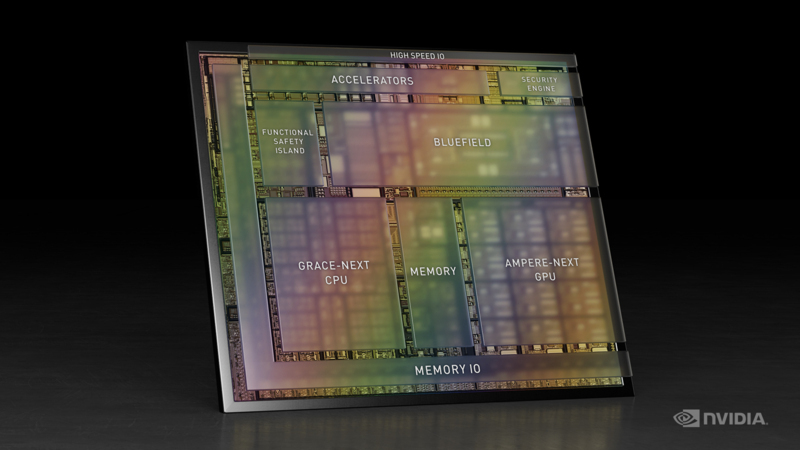 EMERGING TECH
EMERGING TECH
 EMERGING TECH
EMERGING TECH
 EMERGING TECH
EMERGING TECH
Nvidia Corp. is driving ahead with its ambition to power the world’s autonomous vehicles, announcing what the next addition to its Nvidia DRIVE infrastructure portfolio will look like.
Unveiled today at Nvidia’s virtual GPU Technology Conference, Nvidia DRIVE Atlan (pictured) is said by the company to be a “data center on wheels” that helps to centralize a vehicle’s entire compute infrastructure onto a single system-on-chip or SoC.
Nvidia said the DRIVE Atlan SoC is a work in progress that probably won’t appear for a couple of years because the company is still working to ensure that ensure its core AI technology meets the demands of the next generation of autonomous vehicles.
In a presentation, Nvidia explained that autonomous vehicle tech is developing faster than ever, and that AI compute capabilities need to advance in lockstep with the latest developments. It said it believes the cars and trucks of the future will need a highly optimized AI architecture not just to drive them, but also to power intelligent features such as speech recognition and driver monitoring. The cars of the future will be able to converse with their occupants, Nvidia said, answering questions and providing directors and warnings of road conditions ahead, while simultaneously helping to entertain passengers.
Autonomous vehicles will also need to be kept secure from hackers. Nvidia noted that they lack the physical security that comes with data center processing in the cloud.
To that end, the future Nvidia DRIVE Atlan architecture will be the first SoC that’s equipped with Nvidia’s BlueField data processing units, which can process data generated by vehicles in a secure, hardware-based environment.
DRIVE Atlan will also include Nvidia’s GPUs and its new Arm-based CPU cores, as well as deep learning and computer vision accelerators. They will provide a “data-center-like performance” that Nvidia says will give automakers the compute capabilities they need to build software-defined vehicles that are “richly programmable and perpetually upgradeable through secure, over-the-air updates.”
Nvidia claims the chips will run an unprecedented 1,000 trillion operations per second of performance and an estimated SPECint score of more than 100, greater than the total compute power available in all robotaxis today.
In a briefing, Danny Shapiro, senior director of Automotive at Nvidia, said Atlan is designed to provide an “unprecedented level of performance and safety” for autonomous vehicles with a “four-times performance increase” over the company’s previous generation Nvidia DRIVE Orin architecture.
“Atlan is a technical marvel for safe and secure AI computing, fusing all of Nvidia’s technologies in AI, automotive, robotics, safety and BlueField data centers,” he wrote in a blog post.
Nvidia laid out its production roadmap for the Atlan architecture, saying it hopes to make samples available by 2023 with mass production set to begin by 2025.
Autonomous car makers will require more than just an extremely powerful AI architecture if they’re to get their vehicles onto the road, however. Before they even think about letting their new driverless toys loose on the road, they need somewhere to test those systems. So Nvidia is using its AI expertise to help out there too with a key update to its autonomous vehicle simulation, Nvidia DRIVE Sim.
Nvidia DRIVE Sim is a cloud-based platform that can be used to test autonomous vehicle perception systems, acting as a virtual proving ground for each car and truck’s onboard decision-making processes to ensure they’re up to scratch before they’re tested in the real world.
It’s based on the new Nvidia Omniverse Enterprise platform, which is a 3D graphics design environment that uses ray-tracing techniques to render extremely accurate and photorealistic images in an entirely virtual world.

Designing the next generation of DRIVE Sim required a new approach, Nvidia said, including a new simulator that is repeatable with precise timing and can scale across GPUs and server nodes and simulate sensor feeds with physical accuracy, all in an extensible way.
Nvidia explained that autonomous vehicle simulation can only be effective in scenarios that are repeatable and with highly accurate timing. To that end, the Nvidia Omniverse platform provides tools to schedule and manage both the vehicle sensors and environment rendering functions, across GPUs and nodes to ensure DRIVE Sim is able to handle detailed test environments and equally complex sensor suites.
Nvidia DRIVE Sim on Omniverse will be made available to developers in the summer through an early access program.
With reporting from Robert Hof
Support our mission to keep content open and free by engaging with theCUBE community. Join theCUBE’s Alumni Trust Network, where technology leaders connect, share intelligence and create opportunities.
Founded by tech visionaries John Furrier and Dave Vellante, SiliconANGLE Media has built a dynamic ecosystem of industry-leading digital media brands that reach 15+ million elite tech professionals. Our new proprietary theCUBE AI Video Cloud is breaking ground in audience interaction, leveraging theCUBEai.com neural network to help technology companies make data-driven decisions and stay at the forefront of industry conversations.